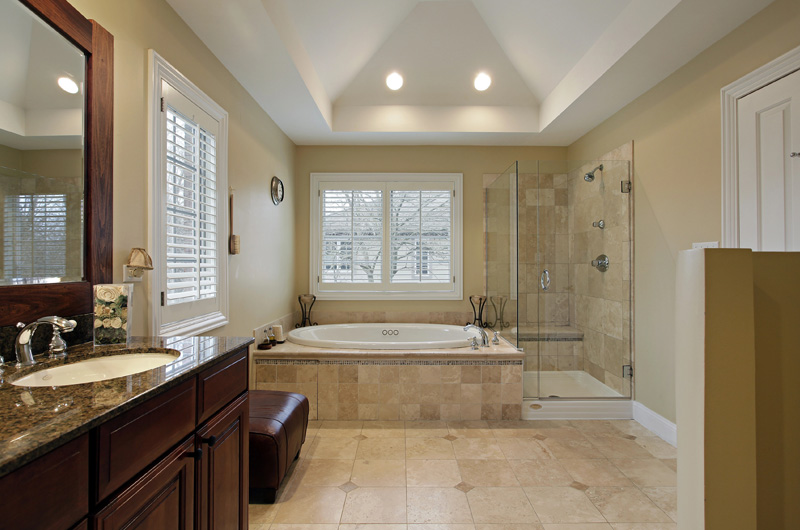When it comes to renovating or designing a bathroom, one of the most crucial decisions you’ll make is selecting the right flooring.
The bathroom floor not only serves a functional purpose but also contributes significantly to the overall aesthetics and ambience of the space. With a plethora of options available in the market, ranging from traditional tiles to modern vinyl and luxurious marble, it’s essential to consider various factors before making a choice.
Important Considerations for Your Bathroom Flooring Project
Practical Considerations
Before delving into the realm of design and style, it’s imperative to address practical considerations when choosing a bathroom floor. The bathroom is a high-moisture environment prone to spills, splashes, and fluctuations in temperature, making waterproofing and durability paramount. Porcelain and ceramic tiles are classic choices known for their resilience and water-resistant properties, making them ideal for bathrooms. They come in a myriad of designs, textures, and colours, allowing homeowners to achieve their desired aesthetic while ensuring functionality.
Additionally, slip-resistance is another crucial factor to contemplate, especially for households with elderly individuals or young children. Opting for tiles with textured surfaces or matte finishes can enhance traction and minimise the risk of accidents, providing peace of mind and safety for all users. Moreover, ease of maintenance is key in a space that is frequently exposed to water and humidity. Choosing materials that are effortless to clean and maintain, such as vinyl or laminate flooring, can simplify upkeep and prolong the floor’s longevity, ensuring a hassle-free bathroom experience.
Design and Aesthetic Appeal
While functionality takes precedence, the aesthetic appeal should not be overlooked when selecting a bathroom floor. The flooring sets the tone for the entire space, influencing the overall style and mood of the bathroom. Whether you prefer a contemporary, minimalist look or a more opulent and luxurious atmosphere, the choice of flooring can make a significant difference.
Natural stone, such as marble or granite, exudes elegance and sophistication, adding a touch of luxury to any bathroom. Its unique veining and textures create a timeless and visually stunning backdrop, elevating the space to new heights of refinement. However, it’s essential to note that natural stone requires regular sealing and maintenance to preserve its beauty and integrity.
On the other end of the spectrum, vinyl and laminate flooring offer versatility and affordability without compromising on style. With advancements in technology, these materials can mimic the look of natural wood, stone, or even intricate mosaic patterns, providing endless design possibilities at a fraction of the cost. Whether you crave the warmth of wood, the sleekness of slate, or the charm of vintage tiles, there’s a vinyl or laminate option to suit every taste and preference.
Budget and Long-Term Investment
Finally, budget considerations and long-term investment should guide your decision-making process when choosing a bathroom floor. While it’s tempting to splurge on high-end materials and extravagant designs, practicality and financial prudence should not be overlooked.
Evaluate your budget constraints and weigh the cost of materials, installation, and maintenance against your desired aesthetic and functional requirements. Keep in mind that investing in quality flooring upfront can save you money in the long run by reducing the need for frequent repairs and replacements.
In conclusion, choosing the perfect bathroom floor requires a careful balance of practicality, design, and budget considerations. By prioritising durability, safety, and ease of maintenance while exploring diverse design options, you can create a stylish and functional bathroom that reflects your unique taste and personality. Whether you opt for timeless tiles, luxurious marble, or budget-friendly vinyl, the right flooring choice can transform your bathroom into a sanctuary of comfort and beauty.
Most common types of flooring used in the bathroom
With a plethora of options available, ranging from classic tiles to innovative materials, it’s crucial to understand the characteristics and benefits of each type to make an informed choice. Let’s delve into the diverse world of bathroom flooring and address key questions that will help you navigate this essential aspect of bathroom design.
Ceramic and Porcelain Tiles
Ceramic and porcelain tiles reign supreme as the go-to choice for bathroom floors, and for good reason. These durable materials are water-resistant, easy to clean, and come in a vast array of colours, textures, and patterns, allowing for endless design possibilities. When considering ceramic or porcelain tiles, ask yourself:
- What is my preferred style and aesthetic? From sleek modern designs to rustic charm, tiles offer versatility to suit any taste.
- Am I concerned about slip-resistance? Opt for textured or matte finishes to enhance traction and minimise the risk of accidents.
- How much maintenance am I willing to commit to? While tiles are generally low-maintenance, grout lines may require periodic sealing to prevent moisture absorption and staining.
Vinyl Flooring
Vinyl flooring has emerged as a popular alternative to traditional tiles, offering affordability, durability, and a wide range of styles. Available in sheets, tiles, or planks, vinyl flooring is resistant to water, stains, and scratches, making it an excellent choice for high-traffic bathrooms. Consider the following questions when exploring vinyl flooring options:
– What is my budget for flooring? Vinyl flooring provides a cost-effective solution without compromising on quality or aesthetics.
– Do I desire a seamless installation? Vinyl sheets offer a seamless surface, minimizing the risk of water infiltration and simplifying maintenance.
– Am I looking for versatility in design? Vinyl flooring can mimic the look of natural materials such as wood, stone, or ceramic tiles, allowing for creative expression without the associated maintenance requirements.
Natural Stone
For those seeking unparalleled luxury and sophistication, natural stone flooring, such as marble, granite, or travertine, delivers unmatched elegance and timeless beauty. Each stone carries unique characteristics, veining, and textures, creating a bespoke look that elevates any bathroom space. Before opting for natural stone flooring, consider the following:
- What is my budget for materials and installation? Natural stone is a premium option that commands a higher price tag than other alternatives.
- Am I willing to invest in regular maintenance? Natural stone requires periodic sealing and gentle cleaning to preserve its lustre and prevent staining.
- Do I prioritise aesthetics over practicality? While natural stone exudes opulence, it may not be the most practical choice for high-moisture environments prone to spills and splashes.
In conclusion, selecting the perfect bathroom flooring involves careful consideration of various factors, including style preferences, budget constraints, and maintenance requirements. Whether you opt for the timeless elegance of ceramic tiles, the affordability of vinyl flooring, or the luxurious allure of natural stone, understanding the pros and cons of each option will help you make an informed decision that meets your needs and enhances your bathroom’s beauty and functionality.
Why you shouldn’t use Wood, Laminate or Carpet
While the bathroom serves as a sanctuary for relaxation and rejuvenation, it also presents unique challenges when it comes to selecting the right flooring. Not all flooring materials are suitable for this high-moisture environment, and choosing the wrong option can lead to costly damage and maintenance issues. In this article, we’ll explore flooring types that you should avoid in the bathroom and address key questions to help you make an informed decision.
Hardwood Flooring Can Swell & Warp
Despite its timeless appeal and warmth, hardwood flooring is not recommended for bathrooms due to its susceptibility to moisture damage. Wood is inherently porous and prone to swelling, warping, and rotting when exposed to prolonged moisture and humidity. Additionally, wood flooring lacks the water-resistant properties necessary to withstand frequent spills and splashes in the bathroom. If you’re considering hardwood flooring for your bathroom, ask yourself:
- Is my bathroom well-ventilated to minimise moisture accumulation?
- Am I willing to invest in regular sealing and maintenance to protect the wood from water damage?
- Can I explore alternative materials that mimic the look of wood without the associated risks?
Carpets trap moisture and are hard to clean
While plush carpeting may add comfort and warmth to other areas of the home, it’s a flooring choice best avoided in the bathroom.
It was even a very popular flooring choice in the UK
Carpet fibers trap moisture, providing an ideal breeding ground for mould, mildew, and bacteria. Moreover, carpets are difficult to clean and prone to staining, making them unsuitable for the inevitable spills and splatters that occur in the bathroom. Consider the following questions before contemplating carpet flooring in your bathroom:
- How frequently will the bathroom be used, and can carpet withstand the heavy foot traffic and moisture exposure?
- Am I prepared to invest in regular professional cleaning to maintain the carpet’s hygiene and appearance?
- Are there alternative flooring options that offer comfort and warmth without compromising on cleanliness and durability?
Laminate Flooring can also lead to swelling and warping
While laminate flooring may offer affordability and a wide range of design options, it’s not an ideal choice for the bathroom due to its susceptibility to water damage. Laminate consists of layers of compressed fibreboard topped with a photographic layer that mimics the appearance of wood, tile, or stone. However, its seams and edges are vulnerable to moisture infiltration, leading to swelling, warping, and separation of the planks. Before opting for laminate flooring in your bathroom, ask yourself:
- Can I ensure meticulous installation to minimise gaps and seams that could allow water to penetrate?
- Am I willing to promptly address any spills or leaks to prevent water damage to the laminate?
- Are there alternative waterproof flooring options that offer the same aesthetic appeal and affordability?
In conclusion, selecting the right flooring for your bathroom involves careful consideration of factors such as moisture resistance, durability, and maintenance requirements.
By avoiding unsuitable options such as hardwood, carpet, and laminate flooring, you can mitigate the risk of water damage and ensure a functional and aesthetically pleasing bathroom space for years to come. Always consult with flooring professionals to explore alternative materials that meet your needs and enhance your bathroom’s beauty and functionality.




